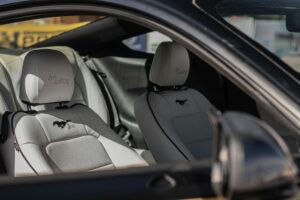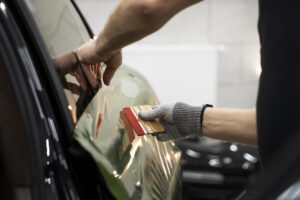Living in Salt Lake City means experiencing the full spectrum of Mother Nature’s moods. From scorching summer heat that bakes the valley floor to winter storms that dump feet of snow in the mountains, your vehicle faces a constant assault from the elements. Many car owners turn to ceramic coating as their armor of choice, but how well does this protection really hold up against Utah’s dramatic weather swings?
The marketing promises sound almost too good to be true. Five years of protection. Ten years. Some companies even claim lifetime durability. But when you’re navigating icy roads treated with mag chloride in January and then parking under the blazing sun at 100°F in July, those claims deserve scrutiny.
Understanding Ceramic Coating in Real-World Conditions
Ceramic coating isn’t magic, though it might seem like it when water beads up and rolls off your hood like mercury. At its core, this technology creates a semi-permanent bond with your vehicle’s clear coat, forming a protective layer measured in nanometers. Think of it as an invisible shield that’s harder than your car’s paint but flexible enough to expand and contract with temperature changes.
The chemistry behind ceramic coatings involves silicon dioxide (SiO2) or titanium dioxide (TiO2), compounds that create a glass-like surface when properly cured. This surface resists UV rays, chemical contaminants, and minor scratches better than traditional waxes or sealants. But here’s where Salt Lake City’s unique environment enters the equation.
Temperature fluctuations in the Salt Lake Valley can swing 40 degrees in a single day. Your ceramic coating experiences this thermal cycling repeatedly, expanding in the afternoon heat and contracting in the cool mountain air that descends each evening. Quality matters immensely here. Budget ceramic coatings often use lower concentrations of active ingredients and cheaper polymers that become brittle under this stress.
Professional-grade coatings, particularly those with SiO2 concentrations above 80%, maintain their flexibility and adhesion despite these temperature swings. The key lies in the cross-linking polymers that allow the coating to move with your paint rather than fighting against it.
Salt Lake City’s Seasonal Challenges
Winter Warfare
Salt Lake City winters present a triple threat to your vehicle’s finish: road salt, mag chloride, and freeze-thaw cycles. The Utah Department of Transportation uses magnesium chloride extensively on state roads, and while it’s effective at melting ice, it’s also highly corrosive to unprotected surfaces.
Ceramic coatings excel here by creating a barrier that prevents these chemicals from reaching your paint. The hydrophobic properties mean that slush and brine slide off rather than sitting on your panels and eating away at the finish. However, this protection isn’t absolute. Mag chloride is particularly aggressive, and even ceramic-coated vehicles need regular washing during winter months to prevent chemical buildup in crevices and panel gaps.
The freeze-thaw cycle poses another challenge. Water finds its way into microscopic imperfections, freezes, expands, and can compromise the coating’s integrity over time. Premium ceramic coatings with self-healing properties fare better, as minor damage repairs itself when exposed to heat – even the modest warmth of winter sunshine can activate this feature.
Summer Scorchers
When summer arrives, the Salt Lake Valley transforms into a high-altitude oven. UV radiation at 4,300 feet elevation is significantly more intense than at sea level. Unprotected paint oxidizes rapidly, clear coats fail, and plastic trim fades to that telltale chalky gray.
Ceramic coatings contain UV inhibitors that act like sunscreen for your car. The silicon dioxide layer reflects and absorbs harmful radiation before it reaches your paint. This protection remains stable even when surface temperatures exceed 140°F on dark-colored vehicles parked in direct sunlight.
The thermal resistance of quality ceramic coating also helps manage heat buildup. While it won’t keep your car cool, it does reduce the thermal stress on your paint system. This becomes particularly important for vehicles with metallic or pearl finishes, which are more susceptible to heat-related degradation.
Spring and Fall Transitions
Utah’s transitional seasons bring their own challenges. Spring delivers pollen bombs that coat everything in yellow dust, while fall brings temperature swings that can see frost in the morning and t-shirt weather by afternoon. These seasons test a ceramic coating’s ability to repel organic contaminants and handle rapid temperature changes.
Quality ceramic coatings make spring cleaning much easier. Pollen, tree sap, and bird droppings don’t bond as readily to the slick surface, and what does land usually removes with gentle pressure washing. The coating’s chemical resistance prevents etching from acidic contaminants – crucial protection during spring when bird activity peaks.
Real Durability Expectations
Marketing claims aside, here’s what Salt Lake City car owners can realistically expect from professional ceramic coating:
Premium professional-grade ceramic coatings typically maintain strong hydrophobic properties for 2-3 years in our climate. The coating itself may last 5-7 years, but its performance gradually diminishes. Water beading becomes less dramatic, contaminant resistance decreases, and the self-cleaning effect fades.
Several factors accelerate this degradation in our market. Frequent trips through automatic car washes with harsh chemicals and spinning brushes can reduce coating life by 50% or more. Parking outdoors year-round exposes the coating to maximum UV radiation and temperature cycling. Neglecting maintenance washes allows contaminants to bond with and compromise the coating surface.
Vehicles garaged nightly and washed properly can see dramatically extended coating life. Some of our customers report strong performance after 4-5 years when following proper care protocols. The investment in covered parking often pays for itself in extended coating durability and reduced paint damage.
Maximizing Ceramic Coating Lifespan in Utah
Success with ceramic coating in Salt Lake City requires adapting your maintenance routine to our unique conditions. During winter months, rinse your vehicle weekly to remove road chemicals, even if it doesn’t look dirty. That invisible layer of mag chloride continues its corrosive work whether you can see it or not.
Use pH-neutral car shampoos specifically designed for ceramic coatings. Traditional car wash soaps often contain gloss enhancers and waxes that can mask the coating’s hydrophobic properties. Avoid automatic car washes entirely if possible – the mechanical action and harsh chemicals are your coating’s worst enemy.
Every 6-12 months, apply a ceramic boost product to refresh the top layer. Think of this as conditioning treatment for your coating, restoring hydrophobic properties and adding sacrificial protection. This simple step can extend effective protection by years.
Consider combining ceramic coating with paint protection film on high-impact areas. The front bumper, hood, and mirror caps take the brunt of rock chips and road debris. PPF in these areas preserves both your paint and the ceramic coating behind it.
Professional Installation Makes the Difference
The durability difference between DIY ceramic coating and professional installation is stark, particularly in challenging climates like ours. Professional installers control temperature and humidity during application, ensure proper surface preparation, and apply multiple layers for maximum thickness.
Paint correction before coating application removes swirl marks, water spots, and oxidation that would otherwise be sealed beneath the coating. This step alone can add years to the coating’s effective life by ensuring optimal bonding to healthy clear coat.
Professional-grade coatings also use carrier solvents that flash off at specific rates, allowing deeper penetration into the clear coat. This chemical bonding is what separates true ceramic coatings from glorified sealants that wash away after a few months.
For those considering the DIY route, understand that Salt Lake City’s low humidity can cause consumer-grade coatings to flash too quickly, preventing proper leveling and causing high spots. Our altitude also affects curing times, and many DIY products don’t account for this variable.
Cost-Benefit Analysis for Utah Drivers
The initial investment in professional ceramic coating ranges from $500 to $2,000 depending on vehicle size and coating quality. This seems steep until you calculate the alternative costs. Traditional waxing every three months costs $50-100 per application, totaling $200-400 annually. Over five years, that’s $1,000-2,000 in wax applications alone.
More importantly, ceramic coating prevents damage that requires expensive correction. Paint oxidation, clear coat failure, and chemical etching from road salts can necessitate paint correction or even repainting. A single panel repaint costs $300-500, making prevention through ceramic coating economically sensible.
The convenience factor also has value. Ceramic-coated vehicles clean faster and easier, saving hours of washing and detailing time annually. For busy professionals, this time savings alone can justify the investment. Adding mobile window tinting in Salt Lake City complements ceramic coating by reducing interior UV damage and heat buildup, creating comprehensive protection for your investment.
Making an Informed Decision
Ceramic coating offers legitimate protection benefits in Salt Lake City’s challenging climate, but it’s not a miracle cure. Understanding its limitations helps set realistic expectations and maximize your investment value.
For daily drivers exposed to all four seasons, ceramic coating provides valuable protection against UV damage, chemical contamination, and minor scratches. The hydrophobic properties make winter maintenance easier and summer cleaning faster. However, it won’t prevent rock chips, door dings, or damage from improper washing.
Garage-kept vehicles see the best return on investment, as reduced exposure to temperature extremes and UV radiation extends coating life significantly. If you’re parking outside year-round, consider mid-tier coating options that balance performance with replacement cost, as you’ll likely need reapplication sooner.
The bottom line: ceramic coating works well in Salt Lake City when properly applied and maintained. It’s not permanent, despite marketing claims, but it does provide superior protection compared to traditional waxes and sealants. Understanding our unique climate challenges and adapting your maintenance accordingly ensures you get maximum value from this protective technology.
Quality ceramic coating remains one of the best investments for preserving your vehicle’s appearance and value in Utah’s four-season climate. Just remember that like any investment, its performance depends on choosing quality products, professional installation, and proper maintenance adapted to our unique environmental challenges.
FAQs
How long does ceramic coating really last on cars in Salt Lake City?
Professional-grade ceramic coating typically maintains strong protection for 2-3 years in Salt Lake City’s climate, with the coating itself lasting 5-7 years but with diminishing performance. Garaged vehicles with proper maintenance can see effective protection for 4-5 years.
Does ceramic coating protect against road salt and mag chloride used in Utah winters?
Yes, ceramic coating creates a chemical-resistant barrier that prevents road salt and magnesium chloride from directly contacting your paint. However, regular washing during winter months is still necessary to prevent chemical buildup in crevices and maintain the coating’s protective properties.
Is ceramic coating worth it for vehicles parked outside in Utah?
Ceramic coating provides valuable UV protection and chemical resistance for outdoor-parked vehicles, but expect shorter lifespan due to constant exposure. Consider mid-tier coating options that balance performance with replacement cost, as you’ll likely need reapplication every 2-3 years.
Can I apply ceramic coating over window tint or PPF?
Ceramic coating can be applied over paint protection film but not directly over window tint. For comprehensive protection, install PPF first on high-impact areas, then apply ceramic coating over both the PPF and painted surfaces for maximum durability.
What’s the best maintenance routine for ceramic-coated cars in Salt Lake City?
Wash your vehicle every 1-2 weeks using pH-neutral shampoo designed for ceramic coatings. During winter, rinse weekly to remove road chemicals. Apply ceramic boost spray every 6-12 months, avoid automatic car washes, and consider professional decontamination annually to maintain optimal performance.



